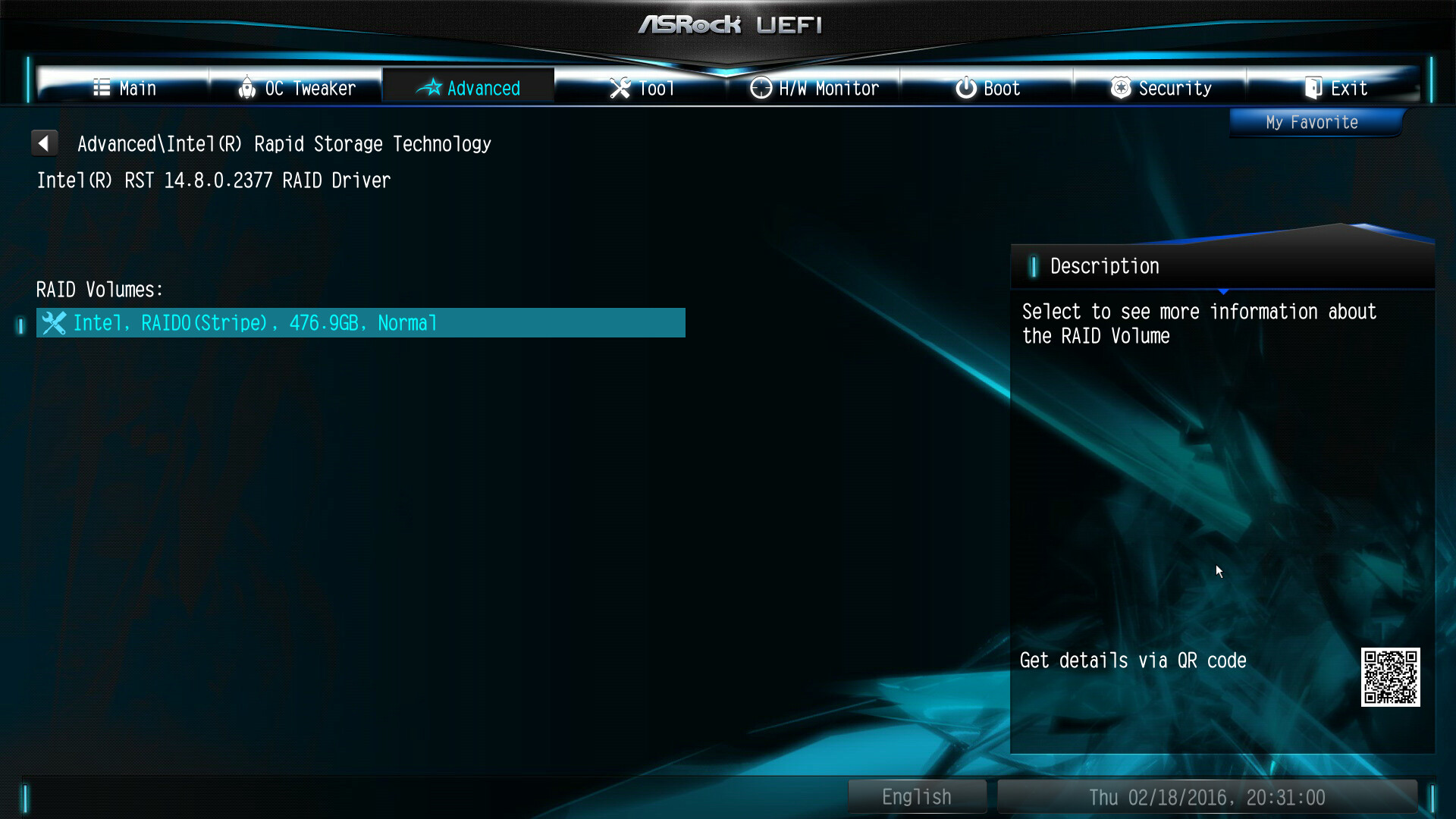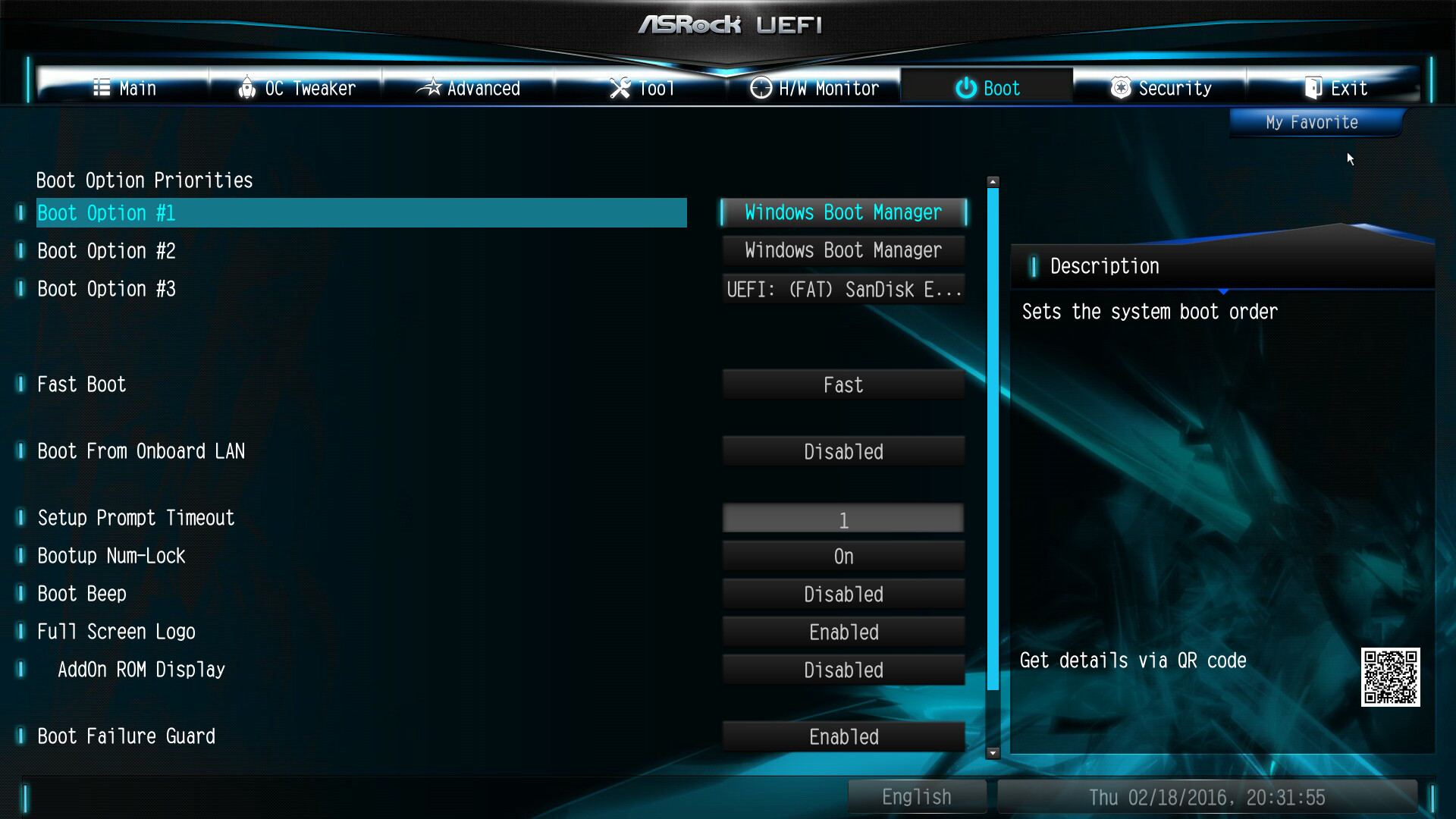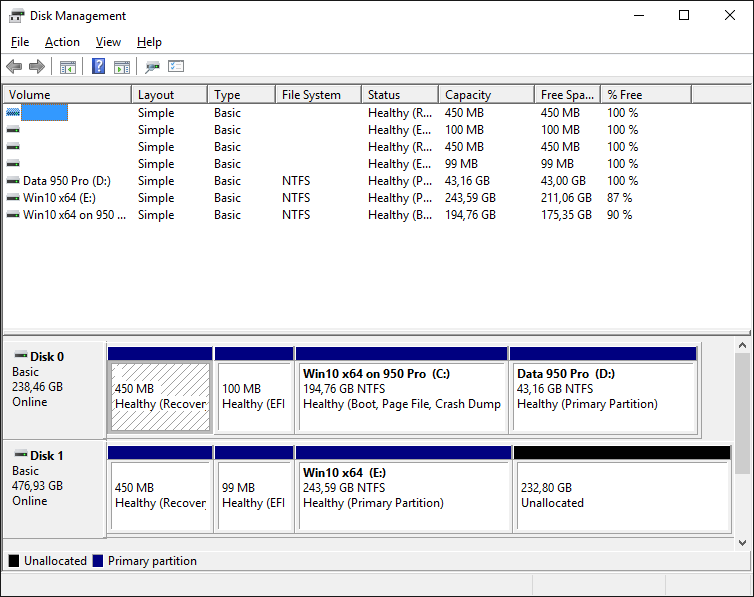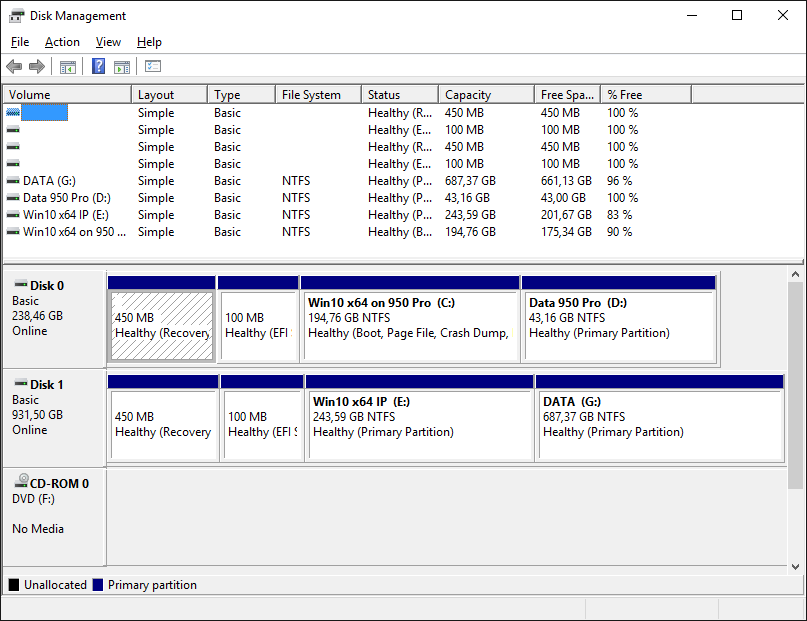Hello everyone
I know it sounds kind of implausible, and if I read that title I’d think the user was probably too ignorant and just blaming perfectly functional software for his failures, we all know the type. But please hear me out.
I am using an Asrock Extreme 4 z97 with the newest (2.30) BIOS und up until recently I was happily using a RAID5 on the Intel Chipset controller together with a seperate SSD as a boot device. Now my new shiny Samsung 950 Pro, NVMe, M.2 connected, has arrived and I set out moving and, after some complications, reinstalling Windows on the new SSD.
Through trial and error I have discovered that apparently my graphics cards, two Radeon 7850 need the Compatibility Support Module and cannot directly interface with the UEFI. So CSM has to be enabled. However the 950 Pro does not like the CSM at all. No matter if I set the Storage OpROM Policy to Legacy Only apparently that still picks up the drive and somehow prevents it from booting consistently. So I had to set it to Do Not Launch in order to boot from the 950.
However in order to use the Intel RAID OROM I need to set it either to Legacy Only, in which case I can use the BIOS module (CTRL-I) or to UEFI Only which enables me to use the UEFI Module from the advanced page in the UEFI. In that regard I see pretty much the same parsec describes over at tweaktown, despite it being the model before mine.
Now I have just the tiniest bit of an idea how a BIOS looks and works, since my old board had another bug concerning the PCI-e lane allocation and I kind of tried to mod the BIOS myself. I swear I’m not making this up, I even found another guy being frustrated with the bug in the model before mine, he wanted to use four RAID cards and couldn’t get it to work and they sent him a beta BIOS which he sent along to me. Found him again: Pauven on lime-technology
Anyway this tiniest idea tells me that it should be possible to load both the Intel RAID OROM for UEFI and still handle the 950 Pro without the CSM, since both should be UEFI modules, or is that wrong? Is there a good reason why the Intel RAID Options should disappear from the UEFI if I set the Storage OpROM Policy to Do Not Launch? Or is it just Asrock being lazy about updating?
The way I interpret it is that there are both modules there in my BIOS NVMe and Intel RST and both seem to work but never together, if that is right, is there hope with any modding? Perhaps reordering some modules or something? I feel like I don’t really understand what’s going on yet.
I’d love to borrow your expertise here!
Greetings
Katana
PS: I have seen the “[Guide] How to get full NVMe support for Intel Chipset systems from 6-Series up” and accompanying discussion but it seems people there are mostly adding NVMe capabilities to boards that don’t support it from the get go.
The easiest way to get rid of that is to insert GOP drivers into your graphic cards VBIOSes using GOPUpd and update them with atiflash from DOS. Then you can just disable CSM and use UEFI as is supposed to be used nowadays.
@Katana :
Welcome at Win-RAID Forum!
If you want to solve your UEFI boot problem, I recommend to follow the advice given by CodeRush.
Good luck!
Dieter (alias Fernando)
Hey hello guys.
I should have thanked you when I first read your replies, sorry for all the delay.
Anyway, I was successful in modding and flashing the VBIOS on both cards! It was my first VBIOS flash. Although I suspect flashing the primary would have sufficed, since all I need it to do is boot into my OS and handing over control, but I’d rather have them on the same firmware so I flashed both. One after the other, I’m not that careless 
Unfortunately this doesn’t solve my original issue. I could now disable CSM entirely and successfully boot into UEFI (yay!) however then my NVMe SSD wasn’t recognized any more*, so Windows wouldn’t boot. I tinkered around and found that the SSD would be properly recognized once I turned the SATA mode from RAID to AHCI. However, if you recall, my goal was to use the NVMe SSD together with a RAID. So I’m not really any closer to that, as it seems. But I hope this gives us more flexibility down the road.
I am now a little worried if I am currently even booted in NVMe mode, since the SATA mode is called AHCI explicitly and I’m not sure how to figure it out. My Device Manager looks good I think.
Can you think of any other way to make both RAID and NVMe usable at once? If I am currently in NVMe mode despite having AHCI selected for SATA would it be possible to take whatever component makes that possible and move it into the RAID mode?
*And I mean not recognized at all, there is a separate bug / missing feature in the interface in that the NVMe SSD is never listed in the storage section, but when I can’t see it among the bootable devices I can be pretty sure that it’s really not recognized.
Hi!
Did you set the "Fast boot mode" in UEFI setup to something faster than "Normal"?
What is the version of the Intel RST UEFI module? You can see this information in the UEFI setup.
Hello
I have now tried all six combinations of Fast Boot modes and SATA modes again to make sure. It seems to have no effect* whether I set "Fast Boot" to "Disabled", "Fast" or "Ultra Fast". In any of the cases where SATA is set to AHCI it will boot from the SSD and if SATA is st to RAID it will not.
The Intel RST version number displayed if I set SATA to RAID and enter the raid configuration from the UEFI configuration menus is "Intel RST 13.0.0.2075". I assume this is the version of the UEFI module and the one which I used to enter when CSM was active by pressing Ctrl-I was the BIOS module, correct?
Thank all of you who replied to my thread so far!
*The boot time is different and the amount of diagnostics I am shown at boot change as expected
Just to give anyone still reading this an update, I have contacted AsRock to see if they can help pinpoint the problem, so far I have only gotten some instructions on how to install windows on my NVME drive. However those instructions call for setting SATA mode to RAID, enabling the CSM and setting the Storage OpROM policy to UEFI only, which leads to a bluescreen* that occurs when Windows is loading from the (twice freshly imaged) installation thumb drive. Also with this combination of settings I can’t boot my current installation either.
*with error IRQ_DRIVER_NOT_LESS_OR_EQUAL (iaStorAV.sys)
@Katana :
Since I have a rather similar mainboard (look into my signature) and a Samsung 950 Pro SSD as well, I would be able to do some tests.
What shall I do?
@Katana :
Meanwhile I have done a test trying to simulate your hardware configuration.
This was the test procedure:
- As first step I removed all HDDs/SSDs and set the Intel SATA Controller to “RAID”. All other BIOS settings from my previous usage running a 1 TB Samsung 850 EVO SSD in AHCI mode were left untouched (“CSM” Disabled, “Fast Boot” etc.).
- After hing inserted the Samung 950 Pro SSD into the M.2 slot no 1 I did a fresh install of the Win10 x64 Pro Insider Preview Build 14267 onto it. The installation ran without any problem. Note: The “Intel Rapid Storage Manager” tab was not seen at this time within the UEFI BIOS.
- As next step I connected an already existing RAID0 array (2x256 GB Samsung 840 Pro SSDs with a bootable Win10 x64 on it) to the first 2 Intel SATA ports.
- After having rebooted 2 times and powerde off the computer for half a minute, I entered the UEFI BIOS.
As you can see here, the Intel EFI RaidDriver v14.8.0.2377 resp. the “Rapid Storage Technology” tab was visible and obviously had successfully detected the RAID0 array:

Here are my BIOS settings within the "BOOT" section:
- After having saved these BIOS settings and rebooted, the system booted straight into the Win10 x64 partition, which was on the Samsung 950 Pro SSD.
As you can see here, the Win10 Disk Management has properly detected the RAID0 array as 1 Disk Drive:
[[File:Win10 Disk Management 950 Pro + RAID0.png|none|auto]] - As last step i removed the 2 SSDs, which were members of a RAID0 array, reconnected my 1 TB Samung 850 EVO, entered the BIOS and set the Intel SATA Controller to "AHCI".
- After having turned off the computer for half a minute, I was able to reboot into the Samsung 950 Pro SSD.
This is what the Disk Management showed now:
[[File:Win10 Disk Management 950 Pro + AHCI SATA Drive.png|none|auto]]
I hope, that this test may help you to get your problem solved.


@Fernando :
Thank you very much for going through all of this. I’m kind of glad to hear that it worked in your case and more or less how I would expect it to work. It gives me hope that it’s not me who is going crazy here.
Yesterday I pretty much did exactly the same thing you did in steps one and two. I disconnected everything, including USB devices, my card reader, all harddrives except for the 950 pro. Then I reset my UEFI settings, changed Intel SATA mode to RAID and set the Storage OpROM policy first to UEFI only, later to the other two options and with switched off CSM, and tried to install Windows 10 64bit as downloaded from the media creation tool yesterday. That is what AsRock support told me to try and pretty much exactly the same you did, except that I tried some other options with CSM enabled on top of that. Every time I got that damn bluescreen when the installation USB stick was loading.
I hope there is some sort of bug in the NVMe module of my UEFI otherwise I have no idea what it could be. Thanks again, I will post again when AsRock responds again.
EDIT: Wait I actually have mail from them already! I think I’ll allow myself to copy paste it in full:
So, for our English speaking readers, he’s saying he can replicate the BSOD but can also work around it when using a PCI-E adapter card! He will pass it on to the people responsible for BIOS developement.
Yay, rejoice for there is hope ![]()
@Katana :
I am glad, that I maybe was able to help you.
After my tests here are my personal conclusions:
1. The BIOS setting regarding the SATA mode (AHCI or RAID) of the Intel SATA Controller has no impact on the functionality of the M.2 connected SSD. Even a later change of the Intel SATA mode doesn’t matter.
2. Provided, that the CSM has been set to “Disabled”, ASRock Z97 mainboard users, who want to use an NVMe supporting M.2 SSD as system drive, will not see any restrictions regarding the usage of the Intel SATA ports.
Nevertheless I want to let you know a severe issue of my mainboard: Very often (especially while cold booting) it is impossible to boot into the Samsung 950 Pro SSD (the black screen with the ASRock logo on it stays forever, nothing happens). This problem can be solved by powering off and restarting the computer. This issue has never happened with other NVMe supporting SSDs (the Samsung SM951 or Intel 750), only with the Samsung 950 Pro SSD.
@Fernando :
Thanks for spelling out number 1, I didn’t realize that this was the obvious conclusion, since I am getting stuck earlier than that, but it’s good to know!
Regarding number 2, I would like to remind users of the Z97 Extreme4 specifically that two of the Intel SATA ports - those that can be used for SATA Express - are sharing their connection with the M.2 slots, obviously what Fernando said doesn’t apply to those. That is also why there is the SATA Express or M.2 switch in the storage menu in the UEFI.
I can also confirm that I too have experienced intermittent issues with cold booting from the 950 Pro with one set of UEFI options I was using, though unfortunately I cannot recall how exactly everything was configured. So perhaps we are looking at a bug in Samsung’s SSD firmware that leads to a BSOD with the Extreme4 but only minor inconvenience with the Extreme6. There is no firmware update for the 950 Pro to be found yet.
Fernando did you see my edit above?
Yes, I have seen it.
That is why I have reported about my issue while cold booting the Samsung 950 PRO. So you can give the ASRock Service the information, that you are not the only user of the ASRock Z97 Extreme series, who has problems with the usage of the Samsung 950 PRO.
By the way: I don’t think, that the cold boot problem is Firmware related, because otherwise we would have found in the NET a lot of user reports about this issue. I suspect, that a faulty BIOS module may provoke the cold boot issue.
Okay, so, for my report:
AsRock have sent me a new version of the UEFI, version 2.31, attached to this post, which seems to work perfectly.
I now have the RAID back up and running as well as my NVMe SSD working as a boot device.
Thanks to that and the vbios modding I can now turn off the CSM completely and have my system booting in pure UEFI mode.
As an added bonus the UEFI menu has gotten more sane, I can now actually see connected NVMe devices in their own submenu.
Thanks to everyone who replied to me, and kept me sane and going with the testing.
And especially to you Fernando for even reproducing the error with your similar hardware. I hope the UEFI may be of use to you too.
All the best,
Katana
Z97Ex42.zip (5.61 MB)
@Katana :
Thank you very much for your report. It is fine, that ASRock gave you access to an updated BIOS, which obviously has solved all your previous problems.
I hope, that ASRock will publish very soon similarly updated BIOSes for all their Z97 mainboards.